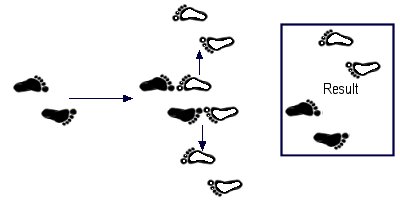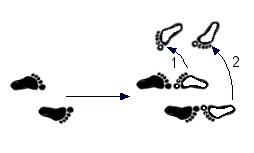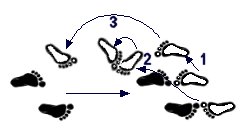Footwork!
When people speak of "footwork" what comes to mind for you? The short answer I suppose is "stepping" or "movement". But that's a bit vague, isn't it?
I have seen a number of exercises in footwork, often demonstrated by people held in generally high regard within their own school or system, and often they do little to inspire confidence in the technical knowledge of the teacher. There are senior people within a club teaching their senior students what they refer to as "advanced" techniques but they are little more than basic techniques of movements dressed up with some hand techniques as part of the package. After all, there are only so many ways you can present methods of stepping in a straight line!
Despite such assurances as "footwork is the key to..." or "any good instructor understands the importance of footwork" in these cases it seems there is little offered besides how to step forwards or backwards in a straight line. The question is whether this instructor knows what he/she is talking about or are they just catering to the lowest common denominator? I'm sure everyone knows the basic straight line movement:
front foot advances then back foot
back foot steps up then front foot advances
back foot steps through to become front foot
Then when it comes to two-person drills and free sparring it often doesn't get any more complicated than that. Person A steps up to deliver technique/combination, person B holds their position to defend and counter or moves back to defend and counter. There are eight directions of movement available to us, but in many cases only one direction is ever utilised - straight backward.
What of the other seven? Forward, left, right and the angles between? 
As I've mentioned, one of the most common situations is moving backwards. Attacker moves in, defender moves away. No advantage is gained by either person.

However moving left or right immediately presents other options:

In this simplistic view, a sidestep places the defender to (yep you guessed it) the side of the oncoming attacker. Movement in this manner may not seem to have any advantage initially because the defender is looking the wrong way - still facing the same direction instead of facing the attacker to effect a counter. This can be easily fixed with <gasp> simple footwork!

Essentially it just involves the defender turning as they step to the side to remain oriented towards the attacker while the attacker is still facing in their direction of travel. And although it sounds simple, many people struggle with this especially when attack/defence is added to the movement.
This simple movement can be adjusted to move sideways and a little forward, or sideways and a little backward to allow different positioning depending whether the initial response to the attack is to be a strike or kick which will of course require different distancing.
Then too we can make the footwork a little more complex again:

In this instance defender leads out with the right foot as in the previous example (sidestep), but then steps through with the left which requires them to pass alongside the attacker without a large turning inwards to face them at this point. The left foot is also turned outwards on this step and then pivots as the right foot follows through (3) to take the rear of the attacker. Clearly from such a position there are many techniques which could be delivered at close range without the attacker being able to respond effectively.
As with anything of even a slightly technical nature it is much easier to learn with a hands-on approach than from a written description, and this is no exception. There are any number of details and subtleties including the incorporation of receiving techniques ("blocks") and attacks which are difficult to describe in any depth simply by virtue of the number of possible combinations.
Finally, while all these examples have been given from the point of view of a response to an attack, there is no reason they cannot be taken and used in an offensive manner. And some people are just naturally offensive to begin with!
- Mick Todd